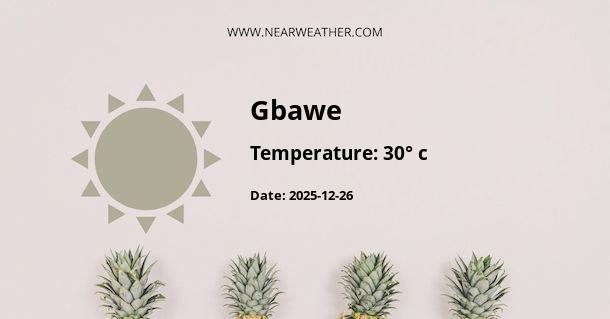Climate and Weather in Gbawe, Ghana
Gbawe is a suburb located in the Greater Accra Region of Ghana. It is known for its vibrant culture, bustling markets, and friendly inhabitants. Understanding the climate and weather patterns in Gbawe is essential for residents and tourists alike. In this article, we will explore the year-round climate in Gbawe, including temperature, precipitation, and other relevant weather factors.
Temperature
The temperature in Gbawe remains relatively consistent throughout the year, with only slight variations. The average annual temperature ranges from 25°C (77°F) to 32°C (90°F). The hottest months are typically between December and March, where temperatures can reach as high as 35°C (95°F). The coolest months are usually between June and August, with temperatures averaging around 25°C (77°F).
The warm temperatures make Gbawe an inviting destination for those who enjoy spending time outdoors. However, it is important to take precautions against the heat and stay hydrated, especially during the hottest months.
Precipitation
Gbawe experiences a tropical savanna climate, characterized by distinct wet and dry seasons. The wet season usually begins in April and lasts until October, with the heaviest rainfall occurring between June and September. During this period, Gbawe receives an average of 1400mm to 2000mm (55 to 79 inches) of rainfall annually.
The dry season, on the other hand, typically starts in November and lasts until March. During this period, rainfall significantly decreases, and Gbawe experiences sunny and dry weather. The average monthly precipitation during the dry season is around 20mm to 50mm (0.8 to 2 inches).
It is worth noting that the rainfall in Gbawe can sometimes be unpredictable, with occasional heavy downpours. It is advisable to carry an umbrella or raincoat during the rainy season to be prepared for any sudden showers.
Humidity
Like many other locations in Ghana, Gbawe experiences high humidity levels throughout the year. The average relative humidity ranges from 70% to 85%. The combination of high temperatures and humidity can make the weather feel hotter than the actual temperature. It is important to take precautions and seek shade or air-conditioned spaces when necessary.
Wind Patterns
Gbawe experiences a prevailing easterly wind, known as the Harmattan wind, during the dry season. The Harmattan wind blows from the northeast and brings dry and dusty conditions to the region. This wind can sometimes lead to reduced visibility and dry skin, so it is advisable to moisturize and protect yourself from the dust during this time.
Climate Chart
| Month | Average Temperature (°C) | Average Rainfall (mm) |
|---|---|---|
| January | 28 | 12 |
| February | 29 | 16 |
| March | 30 | 34 |
| April | 30 | 70 |
| May | 30 | 106 |
| June | 29 | 105 |
| July | 28 | 62 |
| August | 27 | 47 |
| September | 27 | 122 |
| October | 28 | 160 |
| November | 28 | 62 |
| December | 28 | 17 |
The climate chart above provides a visual representation of the average temperature and rainfall in Gbawe throughout the year. It showcases the gradual increase in rainfall from January to October, with the highest precipitation occurring in October. The dry season is evident from November to March, with low rainfall during these months.
Conclusion
Gbawe, Ghana, experiences a tropical savanna climate with warm temperatures throughout the year. The wet season lasts from April to October, characterized by heavy rainfall, while the dry season occurs from November to March, with minimal precipitation. The combination of high temperatures and humidity can make the weather feel hotter than it actually is. Understanding the climate and weather patterns in Gbawe is essential for planning outdoor activities and ensuring personal comfort and safety.
A - Gbawe's Latitude is 5.577140 & Longitude is -0.310350.
A - Weather in Gbawe is 27° today.
A - Climate Conditions in Gbawe shows light rain today.
A - Humidity in Gbawe is 83% today.
A - Wind speed in Gbawe is 5.54 km/h, flowing at 170° wind direction. today.
